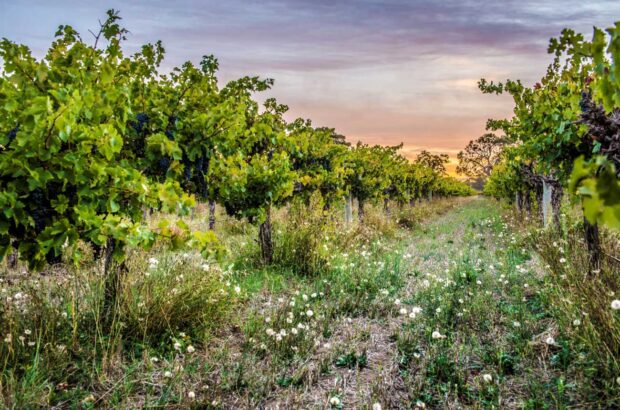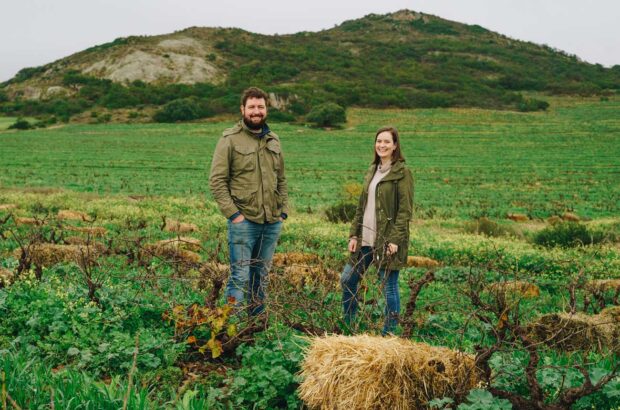The undulating 20-mile stretch between Lisbon and Cascais – known as Estoril Coast (after the coastal town of the same name) and dubbed ‘the Portuguese Riviera’ – is fêted for having 18 sandy beaches and one of Europe’s highest concentration of world-class surf.
However, during the 18th and 19th centuries, Cascais, Carvavelos and Oeiras, three of the coastline’s then rural villages, were mostly celebrated for the latter’s eponymous fortified wine.
When production peaked in the late 18th century, Carcavelos was shipped to England – with pride of place at Christie’s auctions – Brazil and the USA and, more controversially, sold to Douro producers for blending with Port.
Sarah Ahmed’s notes and scores for an exclusive selection of Carcavelos wines below
{"content":"PC9wPgo8aDI+4oCYQSB3aW5lIHRvIGRpZSBmb3LigJk8L2gyPgo8cD5XaXRoIGEgbWVyZSAyMiBoZWN0YXJlcyBhdXRob3Jpc2VkIGZvciBET0MgQ2FyY2F2ZWxvcyBwcm9kdWN0aW9uIHRvZGF5LCBzaXggZXN0YXRlcyBiZWFyIHN0dWJib3JuIHdpdG5lc3MgdG8gdGhpcyB0cmFkaXRpb24gd2hpY2gsIHNhaWQgdGhlIDE5dGggY2VudHVyeSBhZ3Jvbm9taXN0IEFudG9uaW8gQXVndXN0byBkZSBBZ3VpYXIsIHByb2R1Y2VkIOKAmGEgd2luZSB0byBkaWUgZm9y4oCmIHRoYXQga2luZ3MgYW5kIHZhc3NhbHMgd29yc2hpcOKAmS48L3A+CjxwPjxkaXYgY2xhc3M9ImFkLWNvbnRhaW5lciBhZC1jb250YWluZXItLW1vYmlsZSI+PGRpdiBpZD0icG9zdC1pbmxpbmUtMiIgY2xhc3M9ImlwYy1hZHZlcnQiPjwvZGl2PjwvZGl2PjwvcD4KPHA+VGhlIGJlc3Qga25vd24gb2YgYWxsLCBRdWludGEgZG8gTWFycXXDqXMsIGJlbG9uZ2VkIHRvIE9laXJhc+KAmSBtb3N0IGZhbW91cyBhbmQgaW5kdXN0cmlvdXMgZXhwb25lbnQsIHRoZSBNYXJxdcOqcyBkZSBQb21iYWwgKDE2OTktMTc4MiksIHdobyBkb21pbmF0ZWQgUG9ydHVndWVzZSBwb2xpdGljcyBkdXJpbmcgdGhlIHJlaWduIG9mIEtpbmcgSm9zw6kgSSAoMTc1MC0xNzc3KS4gVGhlIGVzdGF0ZSBpcyBub3cgb3duZWQgYnkgdGhlIGxvY2FsIG11bmljaXBhbGl0eS48L3A+CjxwPkluIHRoZSAxOTgwcywgUG9tYmFs4oCZcyBlc3RhdGUgYmVjYW1lIHRoZSBzZWF0IG9mIHRoZSBQb3J0dWd1ZXNlIEFncm9ub21pY2FsIEluc3RpdHV0ZeKAmXMgcmVzZWFyY2ggYWJvdXQgQ2FyY2F2ZWxvcyB3aW5lLiBJdCBwbGFudGVkIGEgbmV3IDUuNWhhIHZpbmV5YXJkIGluIDE5ODMgYW5kIHN1YnNlcXVlbnRseSBwYXJ0bmVyZWQgdXAgd2l0aCB0aGUgbXVuaWNpcGFsaXR5IG9mIE9laXJhcywgd2hpY2ggY3JlYXRlZCB0aGUgVmlsbGEgT2VpcmFzIChmb3JtZXJseSBDb25kZSBkZSBPZWlyYXMpIGJyYW5kIGluIDIwMDkgdG8gcmUtY29tbWVuY2UgdGhlIHByb2R1Y3Rpb24gb2YgQ2FyY2F2ZWxvcyBvbiBhIGNvbW1lcmNpYWwgc2NhbGUuPC9wPgo8ZGl2IGlkPSJhdHRhY2htZW50XzU0NDA1MSIgc3R5bGU9IndpZHRoOiAzMTBweCIgY2xhc3M9IndwLWNhcHRpb24gYWxpZ25jZW50ZXIiPjxpbWcgZmV0Y2hwcmlvcml0eT0iaGlnaCIgZGVjb2Rpbmc9ImFzeW5jIiBhcmlhLWRlc2NyaWJlZGJ5PSJjYXB0aW9uLWF0dGFjaG1lbnQtNTQ0MDUxIiBjbGFzcz0ibGF6eWxvYWQgYmx1ci11cCB3cC1pbWFnZS01NDQwNTEgc2l6ZS1tZWRpdW0iIGRhdGEtcHJvY2Vzc2VkIHNyYz0iaHR0cHM6Ly93d3cuZGVjYW50ZXIuY29tL3dwLWNvbnRlbnQvdGhlbWVzL3NpbWJhLXRoZW1lL2Fzc2V0cy9pbWFnZXMvcGxhY2Vob2xkZXIucG5nIiBkYXRhLXNyYz0iaHR0cHM6Ly9rZXlhc3NldHMudGltZWluY3VrLm5ldC9pbnNwaXJld3AvbGl2ZS93cC1jb250ZW50L3VwbG9hZHMvc2l0ZXMvMzQvMjAyNC8xMS9QYWxhY2lvX01hcnF1ZXNfUG9tYmFsX1JDN0hSNF9BbGFteS0zMDB4MTk4LnBuZyIgYWx0PSJQYWzDoWNpbyBNYXJxdcOqcyBkZSBQb21iYWwsIE9laXJhcyIgd2lkdGg9IjMwMCIgaGVpZ2h0PSIxOTgiIGRhdGEtc2l6ZXM9ImF1dG8iIGRhdGEtc3Jjc2V0PSJodHRwczovL2tleWFzc2V0cy50aW1laW5jdWsubmV0L2luc3BpcmV3cC9saXZlL3dwLWNvbnRlbnQvdXBsb2Fkcy9zaXRlcy8zNC8yMDI0LzExL1BhbGFjaW9fTWFycXVlc19Qb21iYWxfUkM3SFI0X0FsYW15LTMwMHgxOTgucG5nIDMwMHcsIGh0dHBzOi8va2V5YXNzZXRzLnRpbWVpbmN1ay5uZXQvaW5zcGlyZXdwL2xpdmUvd3AtY29udGVudC91cGxvYWRzL3NpdGVzLzM0LzIwMjQvMTEvUGFsYWNpb19NYXJxdWVzX1BvbWJhbF9SQzdIUjRfQWxhbXktNjMweDQxNy5wbmcgNjMwdywgaHR0cHM6Ly9rZXlhc3NldHMudGltZWluY3VrLm5ldC9pbnNwaXJld3AvbGl2ZS93cC1jb250ZW50L3VwbG9hZHMvc2l0ZXMvMzQvMjAyNC8xMS9QYWxhY2lvX01hcnF1ZXNfUG9tYmFsX1JDN0hSNF9BbGFteS0xMzV4ODkucG5nIDEzNXcsIGh0dHBzOi8va2V5YXNzZXRzLnRpbWVpbmN1ay5uZXQvaW5zcGlyZXdwL2xpdmUvd3AtY29udGVudC91cGxvYWRzL3NpdGVzLzM0LzIwMjQvMTEvUGFsYWNpb19NYXJxdWVzX1BvbWJhbF9SQzdIUjRfQWxhbXktMzIweDIxMi5wbmcgMzIwdywgaHR0cHM6Ly9rZXlhc3NldHMudGltZWluY3VrLm5ldC9pbnNwaXJld3AvbGl2ZS93cC1jb250ZW50L3VwbG9hZHMvc2l0ZXMvMzQvMjAyNC8xMS9QYWxhY2lvX01hcnF1ZXNfUG9tYmFsX1JDN0hSNF9BbGFteS02MjB4NDEwLnBuZyA2MjB3LCBodHRwczovL2tleWFzc2V0cy50aW1laW5jdWsubmV0L2luc3BpcmV3cC9saXZlL3dwLWNvbnRlbnQvdXBsb2Fkcy9zaXRlcy8zNC8yMDI0LzExL1BhbGFjaW9fTWFycXVlc19Qb21iYWxfUkM3SFI0X0FsYW15LTkyMHg2MDkucG5nIDkyMHcsIGh0dHBzOi8va2V5YXNzZXRzLnRpbWVpbmN1ay5uZXQvaW5zcGlyZXdwL2xpdmUvd3AtY29udGVudC91cGxvYWRzL3NpdGVzLzM0LzIwMjQvMTEvUGFsYWNpb19NYXJxdWVzX1BvbWJhbF9SQzdIUjRfQWxhbXktMTIyMHg4MDcucG5nIDEyMjB3LCBodHRwczovL2tleWFzc2V0cy50aW1laW5jdWsubmV0L2luc3BpcmV3cC9saXZlL3dwLWNvbnRlbnQvdXBsb2Fkcy9zaXRlcy8zNC8yMDI0LzExL1BhbGFjaW9fTWFycXVlc19Qb21iYWxfUkM3SFI0X0FsYW15LnBuZyAxMzAwdyIgc2l6ZXM9IihtYXgtd2lkdGg6IDMwMHB4KSAxMDB2dywgMzAwcHgiIC8+PHAgaWQ9ImNhcHRpb24tYXR0YWNobWVudC01NDQwNTEiIGNsYXNzPSJ3cC1jYXB0aW9uLXRleHQiPlBhbMOhY2lvIE1hcnF1w6pzIGRlIFBvbWJhbCwgT2VpcmFzLiBDcmVkaXQ6IFPDqXJnaW8gQXplbmhhIHwgQWxhbXkgU3RvY2sgUGhvdG88L3A+PC9kaXY+CjxkaXYgY2xhc3M9ImFkLWNvbnRhaW5lciBhZC1jb250YWluZXItLW1vYmlsZSI+PGRpdiBpZD0icG9zdC1pbmxpbmUtMyIgY2xhc3M9ImlwYy1hZHZlcnQiPjwvZGl2PjwvZGl2Pgo8cD5CeSBmYXIgYW5kIGF3YXkgdGhlIGJpZ2dlc3QsIG1vc3Qgc29waGlzdGljYXRlZCBwcm9kdWNlciwgdGhpcyByZW1hcmthYmxlIHB1YmxpYyBwcm9qZWN0IHNwYXJrZWQgYSByZXZpdmFsLjwvcD4KPHA+RXN0YWJsaXNoZWQgaW4gMTk5NCwgRE9DIENhcmNhdmVsb3MgaXMgYm9vay1lbmRlZCBieSB0aGUgbXVuaWNpcGFsaXR5IG9mIFNpbnRyYSBpbiB0aGUgbm9ydGggYW5kIHRoZSBBdGxhbnRpYyBPY2VhbiB0byB0aGUgc291dGg7IGl0IGVuY29tcGFzc2VzIENhc2NhaXMgYW5kIE9laXJhcyAodGhlIHZpbGxhZ2Ugb2YgQ2FyY2F2ZWxvcyBpdHNlbGYgaXMgbm93IHBhcnQgb2YgdGhlIG11bmljaXBhbGl0eSBvZiBDYXNjYWlzKSwgZXhjbHVkaW5nIHVyYmFuIGFyZWFzLjwvcD4KPGRpdiBjbGFzcz0iYWQtY29udGFpbmVyIGFkLWNvbnRhaW5lci0tbW9iaWxlIj48ZGl2IGlkPSJwb3N0LWlubGluZS00IiBjbGFzcz0iaXBjLWFkdmVydCI+PC9kaXY+PC9kaXY+CjxwPkluIDIwMjEsIHRoZSByZWdpb24gd2FzIGV4dGVuZGVkIHRvIG5vcnRoZXJuIE9laXJhcyB0byBpbmNsdWRlIFF1aW50YSBkYSBDb3JyaWVpcmEsIHBhdmluZyB0aGUgd2F5IGZvciB0aGUgMjAyNCBsYXVuY2ggb2YgUXVpbnRhIGRhIENvcnJpZWlyYSBDb2xoZWl0YSAyMDEyLCB0aGUgZmlyc3QgQ2FyY2F2ZWxvcyB3aW5lIGluIG1vcmUgdGhhbiAyMCB5ZWFycyB0byBoYXZlIGJlZW4gcHJvZHVjZWQgYnkgYSBwcml2YXRlIGVzdGF0ZSwgc3VjaCBpcyBpdHMgcmFyaXR5LjwvcD4KPHA+QWNjb3JkaW5nIHRvIFJvZG9sZm8gVHJpc3TDo28sIHRoZSBkaXN0aW5ndWlzaGVkIHNvbW1lbGllciB3aG8gcHJlc2lkZWQgb3ZlciB0aGUgbGF1bmNoIGFuZCB0YXN0aW5nIG9mIG9sZGVyIHdpbmVzIGZyb20gb3RoZXIgcHJvZHVjZXJzLCBtb3N0IG9mIHdoaWNoIHdlcmUgc291cmNlZCBmcm9tIGNvbGxlY3RvcnMsIOKAmDIwIHllYXJzIGFnbywgbm90IGV2ZW4gUG9ydHVndWVzZSBwZW9wbGUgaGFkIHRhc3RlZCBDYXJjYXZlbG9zLCBldmVuIGlmIHNvbWUgY291bGQgc2VlIHZpbmV5YXJkcyBmcm9tIHRoZWlyIGhvdXNlcy7igJk8L3A+CjxkaXYgY2xhc3M9ImFkLWNvbnRhaW5lciBhZC1jb250YWluZXItLW1vYmlsZSI+PGRpdiBpZD0icG9zdC1pbmxpbmUtNSIgY2xhc3M9ImlwYy1hZHZlcnQiPjwvZGl2PjwvZGl2Pgo8aDI+QSB3aW5lIHRoYXQgbmVhcmx5IGRpZWQ8L2gyPgo8cD5UaGUgcmV2ZXJzYWwgb2YgZm9ydHVuZSB0aGF0IHBsdW5nZWQgQ2FyY2F2ZWxvcyBpbnRvIG9ic2N1cml0eSBiZWdhbiB3aXRoIGFuIG91dGJyZWFrIG9mIHBvd2RlcnkgbWlsZGV3IGluIDE4NTIuIFJlbWFya2luZyDigJhvaWRpdW0gZHJhbmsgaXQgYWxsLOKAmSBkZSBBZ3VpYXLigJlzIHN0YXJrIGNvbXBhcmlzb24gb2YgcHJlLSBhbmQgcG9zdC1vdXRicmVhayBwcm9kdWN0aW9uICgzLDAwMCBiYXJyZWxzIHZlcnN1cyAxMiBpbiAxODY3KSByZXZlYWxzIHRoZSBpbXBhY3Qgb2YgdGhpcyBoYW1tZXIgYmxvdy48L3A+CjxwPkJ5IHRoZSAxODgwcywgcGh5bGxveGVyYSB3YXMgcmlmZSBhbmQgdGhlIHJldHVybiBvZiBvaWRpdW0gYW5kIG1pbGRldyBpbiAxODgxIGJyb3VnaHQgQ2FyY2F2ZWxvcyB0byBpdHMga25lZXMuPC9wPgo8cD5BcyBsZXNzZXIgcmVnaW9ucyB0b29rIHVwIHRoZSBzbGFjaywgc2VsbGluZyBwb29yIGltaXRhdGlvbiBDYXJjYXZlbG9zLCBzdXJ2aXZpbmcgcHJvZHVjZXJzIHN0cnVnZ2xlZCB0byBwcm90ZWN0IHRoZSBDYXJjYXZlbG9z4oCZIGJyYW5kLCBkZXNwaXRlIGRlbWFyY2F0aW5nIHRoZSByZWdpb24gaW4gMTkwOCBhbmQgaW50cm9kdWNpbmcgaW5kdXN0cnkgYm9kaWVzIHRvIHJlZ3VsYXRlIGFuZCBwcm9tb3RlIGl0LjwvcD4KPHA+QnkgdGhlIDE5NTBzLCB3aGVuIFBlZHJvIE1hcnRpbnMgZGUgTGltYSDigJMgUG9ydHVnYWzigJlzIOKAmGZhdGhlciBvZiBzdXJmaW5n4oCZIOKAkyBkaXNjb3ZlcmVkIHRoZSBFc3RvcmlsIGNvYXN0LCB0aGUgd3JpdGluZyB3YXMgb24gdGhlIHdhbGwuPC9wPgo8cD5IYXZpbmcgYmVjb21lLCB0aHJvdWdob3V0IHRoZSB0d28gd29ybGQgd2FycywgYSBzdHlsaXNoIHJlZnVnZSBmb3IgRXVyb3BlYW4gYXJpc3RvY3JhdHMsIGluIHRoZSAxOTUwcyBpdCB0dXJuZWQgZmlybWx5IGludG8gYSBwbGF5Z3JvdW5kIGZvciB0aGUgcmljaC4gVmlsbGFzLCBob3RlbHMgYW5kIExpc2JvbuKAmXMgc3VidXJiYW4gc3ByYXdsIHByb2dyZXNzaXZlbHkg4oCYZHJhbmsgaXQgYWxs4oCZLCB3aXRoIGZldyB2aW5leWFyZHMgbGVmdCBieSB0aGUgZW5kIG9mIHRoZSAxOTgwcy48L3A+CjxwPjxpbWcgZGVjb2Rpbmc9ImFzeW5jIiBjbGFzcz0ibGF6eWxvYWQgYmx1ci11cCBzaXplLW1lZGl1bSB3cC1pbWFnZS01NDQwNTAgYWxpZ25jZW50ZXIiIGRhdGEtcHJvY2Vzc2VkIHNyYz0iaHR0cHM6Ly93d3cuZGVjYW50ZXIuY29tL3dwLWNvbnRlbnQvdGhlbWVzL3NpbWJhLXRoZW1lL2Fzc2V0cy9pbWFnZXMvcGxhY2Vob2xkZXIucG5nIiBkYXRhLXNyYz0iaHR0cHM6Ly9rZXlhc3NldHMudGltZWluY3VrLm5ldC9pbnNwaXJld3AvbGl2ZS93cC1jb250ZW50L3VwbG9hZHMvc2l0ZXMvMzQvMjAyNC8xMS9Db3JyaWVpcmFfbGF1bmNoX2xpbmV1cC0zMDB4MTk5LnBuZyIgYWx0PSIiIHdpZHRoPSIzMDAiIGhlaWdodD0iMTk5IiBkYXRhLXNpemVzPSJhdXRvIiBkYXRhLXNyY3NldD0iaHR0cHM6Ly9rZXlhc3NldHMudGltZWluY3VrLm5ldC9pbnNwaXJld3AvbGl2ZS93cC1jb250ZW50L3VwbG9hZHMvc2l0ZXMvMzQvMjAyNC8xMS9Db3JyaWVpcmFfbGF1bmNoX2xpbmV1cC0zMDB4MTk5LnBuZyAzMDB3LCBodHRwczovL2tleWFzc2V0cy50aW1laW5jdWsubmV0L2luc3BpcmV3cC9saXZlL3dwLWNvbnRlbnQvdXBsb2Fkcy9zaXRlcy8zNC8yMDI0LzExL0NvcnJpZWlyYV9sYXVuY2hfbGluZXVwLTYzMHg0MTcucG5nIDYzMHcsIGh0dHBzOi8va2V5YXNzZXRzLnRpbWVpbmN1ay5uZXQvaW5zcGlyZXdwL2xpdmUvd3AtY29udGVudC91cGxvYWRzL3NpdGVzLzM0LzIwMjQvMTEvQ29ycmllaXJhX2xhdW5jaF9saW5ldXAtMTM1eDg5LnBuZyAxMzV3LCBodHRwczovL2tleWFzc2V0cy50aW1laW5jdWsubmV0L2luc3BpcmV3cC9saXZlL3dwLWNvbnRlbnQvdXBsb2Fkcy9zaXRlcy8zNC8yMDI0LzExL0NvcnJpZWlyYV9sYXVuY2hfbGluZXVwLTMyMHgyMTIucG5nIDMyMHcsIGh0dHBzOi8va2V5YXNzZXRzLnRpbWVpbmN1ay5uZXQvaW5zcGlyZXdwL2xpdmUvd3AtY29udGVudC91cGxvYWRzL3NpdGVzLzM0LzIwMjQvMTEvQ29ycmllaXJhX2xhdW5jaF9saW5ldXAtNjIweDQxMS5wbmcgNjIwdywgaHR0cHM6Ly9rZXlhc3NldHMudGltZWluY3VrLm5ldC9pbnNwaXJld3AvbGl2ZS93cC1jb250ZW50L3VwbG9hZHMvc2l0ZXMvMzQvMjAyNC8xMS9Db3JyaWVpcmFfbGF1bmNoX2xpbmV1cC05MjB4NjA5LnBuZyA5MjB3LCBodHRwczovL2tleWFzc2V0cy50aW1laW5jdWsubmV0L2luc3BpcmV3cC9saXZlL3dwLWNvbnRlbnQvdXBsb2Fkcy9zaXRlcy8zNC8yMDI0LzExL0NvcnJpZWlyYV9sYXVuY2hfbGluZXVwLTEyMjB4ODA4LnBuZyAxMjIwdywgaHR0cHM6Ly9rZXlhc3NldHMudGltZWluY3VrLm5ldC9pbnNwaXJld3AvbGl2ZS93cC1jb250ZW50L3VwbG9hZHMvc2l0ZXMvMzQvMjAyNC8xMS9Db3JyaWVpcmFfbGF1bmNoX2xpbmV1cC5wbmcgMTMwMHciIHNpemVzPSIobWF4LXdpZHRoOiAzMDBweCkgMTAwdncsIDMwMHB4IiAvPjwvcD4KPGgyPlN3ZWV0LCB3aXRoIGEgZHJ5IHNlbnNhdGlvbjwvaDI+CjxwPklyb25pY2FsbHksIGRyaW5rYWJpbGl0eSBoYXMgbG9uZyBiZWVuIGEgQ2FyY2F2ZWxvcyB0cmFpdC4gSXQgY29tYmluZXMgaGFybW9uaW91cyBhY2lkaXR5IHdpdGggdGhlIOKAmHZlbHZldHkgYW5kIHNtb290aCB0YXN0ZeKAmSB3aGljaCwgd3JvdGUgYWdyb25vbWlzdCBhbmQgYWNhZGVtaWMgQmVybmFyZG8gQ2luY2luYXRvIGRhIENvc3RhIGluIDE5MDAsIGVuam95ZWQg4oCYZ3JlYXQgbm90b3JpZXR5IGluIEVuZ2xhbmQgYW5kIEJyYXppbC7igJk8L3A+CjxwPkFsZXhhbmRyZSBFdXJpY28gTGlzYm9hLCBWaWxsYSBPZWlyYXPigJkgdGVjaG5pY2FsIGNvLW9yZGluYXRvciBjb250ZW5kcywg4oCYd2l0aCBoaWdoIGJ1dCB3ZWxsLWJhbGFuY2VkIGFsY29ob2wsIHN1Z2FyLCBhY2lkaXR5IGFuZCBzYWx0aW5lc3MsIENhcmNhdmVsb3Mgc2hvdWxkIGFsd2F5cyBiZSBlbGVnYW50IOKAkyBhIHN3ZWV0IHdpbmUgd2l0aCBhIGRyeSBzZW5zYXRpb24gaW4gdGhlIG1vdXRoLuKAmTwvcD4KPHA+Rm9yIFRyaXN0w6NvLCDigJhhY2lkaXR5IGFuZCBzYWx0aW5lc3MgYXJlIHdoYXQgbWFrZXMgQ2FyY2F2ZWxvcyBzcGVjaWFsLiBUaGUgYXJvbWFzIGFuZCBmbGF2b3VycyBvZiBkcmllZCBmcnVpdHMgYW5kIHNhbHR5IGNhcmFtZWwsIGFsb25nIHdpdGggc2FsaW5pdHkgYW5kIHNtb290aCBzdWdhciB3b3JrIHdlbGwgZm9yIGRlc3NlcnRzLCBjaGVlc2VzIG9yIGV2ZW4gbWFpbiBkaXNoZXMsIHN1Y2ggYXMgZ2FtZSBvciBzdGVhay7igJ08L3A+CjxwPkVtcGhhc2lzaW5nIHRoZSBzaW5ndWxhcml0eSBvZiB0aGUgdGVycm9pciBiZWhpbmQgdGhpcyBwcm9maWxlLCBMaXNib2EgcG9pbnRzIG91dCB0aGUgdmluZXlhcmRz4oCZIHByaXZpbGVnZWQgcG9zaXRpb24gb24gYSByYXJlIHN0cmV0Y2ggb2Ygc291dGgtZmFjaW5nLCBzaGVsdGVyZWQgY29hc3RsaW5lIGJ5IHRoZSBUYWd1cyBlc3R1YXJ5IGFuZCBFc3RvcmlsIEJheS48L3A+CjxwPldlbGwtZXhwb3NlZCB0byB0aGUgc3VuIGFuZCBwcm90ZWN0ZWQgYnkgU2ludHJhIG1vdW50YWluIHJhbmdlLCB2aW5lcyBhcmUgZ2VudGx5IGNvb2xlZCBieSBtaWxkIG9mZnNob3JlIG5vcnRoL25vcnRoLXdlc3Rlcm4gYnJlZXplcyBhbmQgaHlkcmF0ZWQgYnkgbmlnaHQtdGltZSBvY2VhbiBtaXN0cy48L3A+CjxwPkluIGNvbnRyYXN0LCBvbiBQb3J0dWdhbOKAmXMgcHJlZG9taW5hbnRseSB3ZXN0LWZhY2luZyBjb2FzdGxpbmUgYW5kIG92ZXIgdGhlIG90aGVyIHNpZGUgb2YgU2ludHJhIG1vdW50YWluIHJhbmdlLCBuZWlnaGJvdXJpbmcgRE9DIENvbGFyZXMgaXMgZGlyZWN0bHkgZXhwb3NlZCB0byBodW1pZCwgc2FsdHksIEF0bGFudGljIHdpbmRzLjwvcD4KPHA+V2hpbGUsIGxpa2UgUG9ydCBhbmQgTWFkZWlyYSwgQ2FyY2F2ZWxvcyBpcyBtYWRlIGJ5IGFycmVzdGluZyBmZXJtZW50YXRpb25zIHdpdGggd2luZSBzcGlyaXQgYXQgdGhlIGRlc2lyZWQgbGV2ZWwgb2Ygc3dlZXRuZXNzICh0eXBpY2FsbHkgbWVkaXVtLXN3ZWV0KSwgQ2FyY2F2ZWxvc+KAmSBncmFwZSB2YXJpZXRpZXMgKHNlZSBib3ggYmVsb3cpIHNldCBpdCBhcGFydC4gV2hpdGUgQ2FyY2F2ZWxvcyBtYWRlIHdpdGggd2hpdGUgZ3JhcGVzIGN1cnJlbnRseSBwcmVkb21pbmF0ZXMsIGJ1dCByZWQgZXhhbXBsZXMg4oCTIHdoaWNoIHdlcmUgbWFkZSBpbiB0aGUgcGFzdCDigJMgYXJlIHJlYXBwZWFyaW5nLjwvcD4KPHA+T2xkZXIgd2luZXMgc2hvd24gYXQgdGhlIHRhc3RpbmcgaG9zdGVkIGJ5IFRyaXN0w6NvIGluY2x1ZGVkIHdoaXRlIGFuZCByZWQgYmxlbmRzLCBob3dldmVyIExpc2JvYSBiZWxpZXZlcyB0aGF0IHRoaXMgbWl4IG9ubHkgY2FtZSBhYm91dCBiZWNhdXNlIHByb2R1Y3Rpb24gd2FzIHRpbnkgZHVyaW5nIHRoZSAyMHRoIGNlbnR1cnkuIEhlIGNhbGxzIGl0IOKAmHRoZSB3b3JzdCBjZW50dXJ5IHRvIHRhc3RlIENhcmNhdmVsb3MgYmVjYXVzZSBpdCB3YXMgaW4gcnVpbnMgYW5kIHByb2R1Y2VycyBsb3N0IGludGVyZXN0LuKAmTwvcD4KPGgyPkEgcmVhbGl0eSwgbm90IGEgZ2hvc3Q8L2gyPgo8cD5BcyBmb3IgdGhlIDIxc3QgY2VudHVyeSwgTGlzYm9hIGlzIHRocmlsbGVkIGJ5IHRoZSBhcnJpdmFsIG9mIG90aGVyIHByb2R1Y2VycyBiZWNhdXNlIGl0IG1lYW5zIOKAmG5vd2FkYXlzIENhcmNhdmVsb3MgaXMgYSByZWFsaXR5LCBub3QgYSBnaG9zdCBmcm9tIHRoZSBwYXN0LuKAmTwvcD4KPHA+U29tZSBhcmUgd2luZW1ha2VyLWxlZCBwcm9qZWN0cywgd2hpY2ggaGF2ZSBhY3F1aXJlZCB0aGVuIGJsZW5kZWQgbWF0dXJlIHN0b2NrIChIb3dhcmRzIEZvbGx5KSBvciBzb3VyY2VkIGdyYXBlcyB0byBtYWtlIHdpbmVzIGZyb20gc2NyYXRjaCwgbGlrZSBBZGVnYSBCZWzDqW0gYW5kIFZpdG9yIENsYXJvICZhbXA7IFJpdGEgRmVycmVpcmEsIHdob3NlIGdyYXBlcyBjb21lIGZyb20gUXVpbnRhIGRhIFJpYmVpcmEgZGUgQ2FwYXJpZGUsIGEgaGlzdG9yaWMgZmFybSBvd25lZCBieSB0aGUgQ2F0aG9saWMgY2h1cmNoLjwvcD4KPHA+QnJpbmdpbmcgZnJlc2ggcGVyc3BlY3RpdmVzIHRvIHRoZSBnZW5yZSwgQWRlZ2EgQmVsw6lt4oCZcyBlYXJseSByZWxlYXNlIGJhdGNoIG9mIDIwMjEgQ2FzdGVsw6NvIGZpcm1seSBkZXBhcnRzIGZyb20gdHJhZGl0aW9uIGluIHN0eWxlIGFuZCBzdWJzdGFuY2Ugd2l0aCBpdHMgY2FyaWNhdHVyZSBsYWJlbCBhbmQgeW91dGhmdWxseSB2aW5vdXMsIGVkZ3kgcHJvZmlsZS48L3A+CjxwPkl0IHVuZGVyd2VudCBwb3N0LWZlcm1lbnRhdGlvbiBza2luIGNvbnRhY3QgYW5kIHNwZW50IHRoZSBtaW5pbXVtIHBlcmlvZCBpbiBiYXJyZWwgKDI0IG1vbnRocywgdmVyc3VzIHNldmVyYWwgeWVhcnMgZm9yIHR5cGljYWwgZXhhbXBsZXMpLjwvcD4KPHA+Q2xhcm8gYW5kIEZlcnJlaXJh4oCZcyByZWxhdGl2ZWx5IGRlbGljYXRlIDIwMjEgVHJpbmNhZGVpcmEgKHdoaWNoIGRpZCBub3QgdW5kZXJnbyBwb3N0LWZlcm1lbnRhdGlvbiBza2luIGNvbnRhY3QpIHNwZW50IHRoZSBzYW1lIHBlcmlvZCBpbiBiYXJyZWwgYnV0IGlzIG5vdyBhZ2VpbmcgaW4gZ2xhc3MgZGVtaS1qb2hucywgd2hlcmUgaXQgd2lsbCByZW1haW4gZm9yIGF0IGxlYXN0IGFub3RoZXIgdHdvIHllYXJzLjwvcD4KPGRpdiBpZD0iYXR0YWNobWVudF81NDQwNDkiIHN0eWxlPSJ3aWR0aDogMzEwcHgiIGNsYXNzPSJ3cC1jYXB0aW9uIGFsaWduY2VudGVyIj48aW1nIGRlY29kaW5nPSJhc3luYyIgYXJpYS1kZXNjcmliZWRieT0iY2FwdGlvbi1hdHRhY2htZW50LTU0NDA0OSIgY2xhc3M9Imxhenlsb2FkIGJsdXItdXAgd3AtaW1hZ2UtNTQ0MDQ5IHNpemUtbWVkaXVtIiBkYXRhLXByb2Nlc3NlZCBzcmM9Imh0dHBzOi8vd3d3LmRlY2FudGVyLmNvbS93cC1jb250ZW50L3RoZW1lcy9zaW1iYS10aGVtZS9hc3NldHMvaW1hZ2VzL3BsYWNlaG9sZGVyLnBuZyIgZGF0YS1zcmM9Imh0dHBzOi8va2V5YXNzZXRzLnRpbWVpbmN1ay5uZXQvaW5zcGlyZXdwL2xpdmUvd3AtY29udGVudC91cGxvYWRzL3NpdGVzLzM0LzIwMjQvMTEvQ29ycmllaXJhX2xhdW5jaF9jb25mcmFyaWEtMzAweDIwMC5wbmciIGFsdD0iIiB3aWR0aD0iMzAwIiBoZWlnaHQ9IjIwMCIgZGF0YS1zaXplcz0iYXV0byIgZGF0YS1zcmNzZXQ9Imh0dHBzOi8va2V5YXNzZXRzLnRpbWVpbmN1ay5uZXQvaW5zcGlyZXdwL2xpdmUvd3AtY29udGVudC91cGxvYWRzL3NpdGVzLzM0LzIwMjQvMTEvQ29ycmllaXJhX2xhdW5jaF9jb25mcmFyaWEtMzAweDIwMC5wbmcgMzAwdywgaHR0cHM6Ly9rZXlhc3NldHMudGltZWluY3VrLm5ldC9pbnNwaXJld3AvbGl2ZS93cC1jb250ZW50L3VwbG9hZHMvc2l0ZXMvMzQvMjAyNC8xMS9Db3JyaWVpcmFfbGF1bmNoX2NvbmZyYXJpYS02MzB4NDIwLnBuZyA2MzB3LCBodHRwczovL2tleWFzc2V0cy50aW1laW5jdWsubmV0L2luc3BpcmV3cC9saXZlL3dwLWNvbnRlbnQvdXBsb2Fkcy9zaXRlcy8zNC8yMDI0LzExL0NvcnJpZWlyYV9sYXVuY2hfY29uZnJhcmlhLTEzNXg5MC5wbmcgMTM1dywgaHR0cHM6Ly9rZXlhc3NldHMudGltZWluY3VrLm5ldC9pbnNwaXJld3AvbGl2ZS93cC1jb250ZW50L3VwbG9hZHMvc2l0ZXMvMzQvMjAyNC8xMS9Db3JyaWVpcmFfbGF1bmNoX2NvbmZyYXJpYS0zMjB4MjEzLnBuZyAzMjB3LCBodHRwczovL2tleWFzc2V0cy50aW1laW5jdWsubmV0L2luc3BpcmV3cC9saXZlL3dwLWNvbnRlbnQvdXBsb2Fkcy9zaXRlcy8zNC8yMDI0LzExL0NvcnJpZWlyYV9sYXVuY2hfY29uZnJhcmlhLTYyMHg0MTMucG5nIDYyMHcsIGh0dHBzOi8va2V5YXNzZXRzLnRpbWVpbmN1ay5uZXQvaW5zcGlyZXdwL2xpdmUvd3AtY29udGVudC91cGxvYWRzL3NpdGVzLzM0LzIwMjQvMTEvQ29ycmllaXJhX2xhdW5jaF9jb25mcmFyaWEtOTIweDYxNC5wbmcgOTIwdywgaHR0cHM6Ly9rZXlhc3NldHMudGltZWluY3VrLm5ldC9pbnNwaXJld3AvbGl2ZS93cC1jb250ZW50L3VwbG9hZHMvc2l0ZXMvMzQvMjAyNC8xMS9Db3JyaWVpcmFfbGF1bmNoX2NvbmZyYXJpYS0xMjIweDgxNC5wbmcgMTIyMHcsIGh0dHBzOi8va2V5YXNzZXRzLnRpbWVpbmN1ay5uZXQvaW5zcGlyZXdwL2xpdmUvd3AtY29udGVudC91cGxvYWRzL3NpdGVzLzM0LzIwMjQvMTEvQ29ycmllaXJhX2xhdW5jaF9jb25mcmFyaWEucG5nIDEzMDB3IiBzaXplcz0iKG1heC13aWR0aDogMzAwcHgpIDEwMHZ3LCAzMDBweCIgLz48cCBpZD0iY2FwdGlvbi1hdHRhY2htZW50LTU0NDA0OSIgY2xhc3M9IndwLWNhcHRpb24tdGV4dCI+TWVtYmVycyBvZiBDb25mcmFyaWEgZG8gVmluaG8gZGUgQ2FyY2F2ZWxvcy4gQ291cnRlc3kgb2YgUXVpbnRhIGRhIENvcnJpZWlyYTwvcD48L2Rpdj4KPGgyPkluIHRoZSBwaXBlbGluZTwvaDI+CjxwPlRoZSAyMDIxIHZpbnRhZ2Ugd2lsbCBzZWUgdGhlIGZpcnN0IHJlbGVhc2VzIGZyb20gQ2FzY2FpcyBBbWJpZW50ZSwgYSBuZXcgcHVibGljIHByb2plY3QgYnkgQ2FzY2FpcyBNdW5pY2lwYWxpdHkgd2hpY2ggYWNxdWlyZWQgdGhlIFNhbnRhIE1hcmlhIGRvIE1hciBNb25hc3RlcnkgaW4gMjAxNyBhbmQgcmVwbGFudGVkIGl0cyB2aW5leWFyZHMgaW4gMjAxOS48L3A+CjxwPkJvdGggcmVkIGFuZCB3aGl0ZSB2YXJpZXRpZXMgYXJlIHVuZGVyZ29pbmcgc2tpbiBjb250YWN0IGluIHB1cnN1aXQgb2YgYSDigJhtb3JlIHNvYmVyIHdpbmUgcHJvZmlsZSwgY2xvc2UgdG8gNjAvODAgZ3JhbXMgb2Ygc3VnYXLigJkgc2FpZCBpdHMgQ0VPIEx1w61zIEFsbWVpZGEgQ2Fww6NvLjwvcD4KPHA+SGUgZXhwZWN0cyB0aGUgZmlyc3Qgd2luZXMgdG8gbGF1bmNoIGluIDIwMjYgYW5kIHRvIHBsYW50IGF0IGxlYXN0IGFub3RoZXIgNGhhIG9mIHZpbmV5YXJkcyBpbiB0aGUgc2hvcnQvbWVkaXVtIHRlcm0uPC9wPgo8cD5UYWtpbmcgaW50byBhY2NvdW50IFZpbGxhIE9laXJhc+KAmSBpbnRlbnRpb24gdG8gcGxhbnQgYWRkaXRpb25hbCB2aW5lcywgbmV3IHByaXZhdGUgcHJvamVjdHMgcGxhbnRlZCBmcm9tIHNjcmF0Y2ggKFF1aW50YSBWYWxlIFZlcmRlIGFuZCBRdWludGEgZGEgQm9pw6dhKSBhbmQgZWZmb3J0cyB0byByZXZpdmUgZXhpc3RpbmcgZXN0YXRlcyAoUXVpbnRhIGRhIFNhbWFycmEpLCBMaXNib2EgcmVja29ucyB0aGUgYWN0dWFsIChub3QgbmVjZXNzYXJpbHkgYXV0aG9yaXNlZCkgYXJlYSBmb3IgQ2FyY2F2ZWxvcyBwcm9kdWN0aW9uIHdpbGwgaW5jcmVhc2UgdG8gMzhoYSBieSAyMDI1LjwvcD4KPHA+4oCYQ29uc2lkZXJpbmcgdGhhdCB3aGVuIHdlIHN0YXJ0ZWQgaW4gdGhlIDE5ODBzLCB0aGVyZSB3ZXJlIGxlc3MgdGhhbiAxM2hhLCBpdOKAmXMgYSBmYW50YXN0aWMgZ3Jvd3RoLOKAmSBoZSBzYWlkLiBDYXJjYXZlbG9zIG1heSByZW1haW4gbmljaGUgYnV0LCB3aXRoIGFjdGl2ZSBhbmQgbmFzY2VudCBwcm9qZWN0cywgaXTigJlzIGJlY29taW5nIGEgbWFnbmV0IGZvciB0cnVlIHdpbmVsb3ZlcnMgcmF0aGVyIHRoYW4gdGhlIHByZXNlcnZlIG9mIGNvbGxlY3RvcnMuPC9wPgo8aHI+CjxkaXYgY2xhc3M9ImJyZWFrb3V0IHBhbGV0dGUtYSBwYW5lbCBwYW5lbC1kZWZhdWx0Ij48ZGl2IGNsYXNzPSJwYW5lbC1ib2R5Ij48ZGl2IGNsYXNzPSdicmVha291dC1jb250ZW50Jz48L3A+CjxoMiBzdHlsZT0idGV4dC1hbGlnbjogY2VudGVyIj5DYXJjYXZlbG9zOiBLZXkgZmFjdHM8L2gyPgo8cCBzdHlsZT0idGV4dC1hbGlnbjogY2VudGVyIj48c3Ryb25nPlZpbmV5YXJkIGFyZWE6PC9zdHJvbmc+IDIyaGE8L3A+CjxwIHN0eWxlPSJ0ZXh0LWFsaWduOiBjZW50ZXIiPjxzdHJvbmc+UHJvZHVjdGlvbiAoMjAyMyk6PC9zdHJvbmc+IDU3LDAwMCBsaXRyZXM8L3A+CjxwIHN0eWxlPSJ0ZXh0LWFsaWduOiBjZW50ZXIiPjxzdHJvbmc+Q2xpbWF0ZTo8L3N0cm9uZz4gVGVtcGVyYXRlIG1hcml0aW1lPC9wPgo8cCBzdHlsZT0idGV4dC1hbGlnbjogY2VudGVyIj48c3Ryb25nPlNvaWxzOjwvc3Ryb25nPiBDbGF5L2xpbWVzdG9uZTwvcD4KPHAgc3R5bGU9InRleHQtYWxpZ246IGNlbnRlciI+PHN0cm9uZz5XaGl0ZSBncmFwZSB2YXJpZXRpZXMgKG1pbmltdW0gNzUlKTo8L3N0cm9uZz4gR2FsZWdvLURvdXJhZG8sIFJhdGluaG8sIEFyaW50bywgQm9hbCBCcmFuY288L3A+CjxwIHN0eWxlPSJ0ZXh0LWFsaWduOiBjZW50ZXIiPjxzdHJvbmc+V2hpdGUgdmFyaWV0aWVzIChtYXhpbXVtIDI1JSk6PC9zdHJvbmc+IFJhYm8tZGUtT3ZlbGhhLCBTZWFyYS1Ob3ZhPC9wPgo8cCBzdHlsZT0idGV4dC1hbGlnbjogY2VudGVyIj48c3Ryb25nPlJlZCBncmFwZSB2YXJpZXRpZXM6PC9zdHJvbmc+IENhc3RlbMOjbywgQW1vc3RyaW5oYSBhLmsuYS4gUHJldG8gTWFydGluaG8sIFRyaW5jYWRlaXJhIChyZWRzKTwvcD4KPHAgc3R5bGU9InRleHQtYWxpZ246IGNlbnRlciI+PHN0cm9uZz5UaGUgd2luZXM8L3N0cm9uZz48L3A+CjxwIHN0eWxlPSJ0ZXh0LWFsaWduOiBjZW50ZXIiPjxzdHJvbmc+U3R5bGU6PC9zdHJvbmc+IDxlbT5saWNvcm9zbzwvZW0+IChmb3J0aWZpZWQgd2l0aCB3aW5lIHNwaXJpdCk8YnIgLz4KPHN0cm9uZz5NaW5pbXVtIEFnZWluZzo8L3N0cm9uZz4gMjQgbW9udGhzIChpbiB3b29kKSArIDYgbW9udGhzIChpbiBib3R0bGUpPGJyIC8+CjxzdHJvbmc+TWluaW11bSB0b3RhbCBhbGNvaG9saWMgc3RyZW5ndGggYnkgdm9sdW1lOjwvc3Ryb25nPiAxNy41JTxiciAvPgo8c3Ryb25nPlJlc2lkdWFsIHN1Z2FyOjwvc3Ryb25nPjwvcD4KPHAgc3R5bGU9InBhZGRpbmctbGVmdDogNDBweDt0ZXh0LWFsaWduOiBjZW50ZXIiPlNlY28gKGRyeSk6ICZsdDsgNjVnL2w8YnIgLz4KTWVpby1kb2NlIChtZWRpdW0tZHJ5KTogNjUgLTEzMGcvbDxiciAvPgpEb2NlIChzd2VldCk6ICZndDsgMTMwZy9sIChtYXhpbXVtIG9mIDI4MGcvbCk8L3A+CjxwPgo8L2Rpdj48ZGl2IGNsYXNzPSdicmVha291dC1idXR0b25zJz48ZGl2IGNsYXNzPSdyb3cnPjwvZGl2PjwvZGl2PjwvZGl2PjwvZGl2Pgo8aHI+CjxoMT5DYXJjYXZlbG9zIHByb2R1Y2Vyczo8L2gxPgo8aDM+VmlsbGEgT2VpcmFzPC9oMz4KPHA+V2l0aCBhbiBpbXBlY2NhYmxlIHBlZGlncmVlLCBWaWxsYSBPZWlyYXMgd2luZXMgYXJlIHNvdXJjZWQgZnJvbSBhbmQgdmluaWZpZWQgYXQgZXN0YXRlcyB0aGF0IGJlbG9uZ2VkIHRvIHRoZSBNYXJxdcOqcyBkZSBQb21iYWwgYW5kIGNvbXBsZXRlIHRoZWlyIGFnZWluZyBpbiB0aGUgc3BsZW5kb3VyIG9mIGhpcyBwYWxhdGlhbCBCYXJvcXVlIGNlbGxhciwgd2hpY2ggaXMgb3BlbiB0byB0aGUgcHVibGljIGJ5IGFwcG9pbnRtZW50LiBOb3cgd2l0aCAxOWhhIG9mIHZpbmV5YXJkLCBWaWxsYSBPZWlyYXMgaXMgZWFzaWx5IENhcmNhdmVsb3PigJkgYmlnZ2VzdCBwbGF5ZXIuPC9wPgo8cD5XaXRoIFBvcnQtdmV0ZXJhbiBQZWRybyBTw6EgYW5kIEFsZXhhbmRyZSBMaXNib2EgYXQgdGhlIGhlbG0sIHRoZSBzb3BoaXN0aWNhdGVkIHJhbmdlIGlzIHVsdHJhLXNtb290aCBhbmQgYmVhdXRpZnVsbHkgYmFsYW5jZWQsIGZyb20gdGhlIGNvcmUgb2ZmZXIgb2YgNy1ZZWFyLU9sZCBhbmQgMTUtWWVhci1PbGQgYmxlbmRzIHRvIHdoaXRlIGFuZCByZWQgPGVtPmNvbGhlaXRhczwvZW0+IChzaW5nbGUgaGFydmVzdCBDYXJjYXZlbG9zKS48L3A+CjxwPk91dHN0YW5kaW5nIGxpbWl0ZWQgZWRpdGlvbiB3aW5lcyBzdWNoIGFzIHRoZSBNYWhvZ2FueSBHdWl0YXIgQmFycmVsIFByb2plY3QgYW5kIEJ1Z2lvIExpZ2h0aG91c2UgMTkyNCBQaGFyb2VzIDEwMCBZZWFycyByZWZsZWN0IGFuIG9uZ29pbmcgY29tbWl0bWVudCB0byB0aGUgcmVzZWFyY2ggYW5kIHRyaWFscyB1cG9uIHdoaWNoIHRoaXMgaW5ub3ZhdGl2ZSBwdWJsaWMgc2VjdG9yIHBhcnRuZXJzaGlwIGJldHdlZW4gdGhlIFBvcnR1Z3Vlc2UgQWdyb25vbWljYWwgSW5zdGl0dXRlIGFuZCBNdW5pY2lwYWxpdHkgb2YgT2VpcmFzIHdhcyBmb3VuZGVkIGluIDE5OTcuPC9wPgo8ZGl2IGlkPSJhdHRhY2htZW50XzU0NDA1MiIgc3R5bGU9IndpZHRoOiAzMTBweCIgY2xhc3M9IndwLWNhcHRpb24gYWxpZ25jZW50ZXIiPjxpbWcgbG9hZGluZz0ibGF6eSIgZGVjb2Rpbmc9ImFzeW5jIiBhcmlhLWRlc2NyaWJlZGJ5PSJjYXB0aW9uLWF0dGFjaG1lbnQtNTQ0MDUyIiBjbGFzcz0ibGF6eWxvYWQgYmx1ci11cCB3cC1pbWFnZS01NDQwNTIgc2l6ZS1tZWRpdW0iIGRhdGEtcHJvY2Vzc2VkIHNyYz0iaHR0cHM6Ly93d3cuZGVjYW50ZXIuY29tL3dwLWNvbnRlbnQvdGhlbWVzL3NpbWJhLXRoZW1lL2Fzc2V0cy9pbWFnZXMvcGxhY2Vob2xkZXIucG5nIiBkYXRhLXNyYz0iaHR0cHM6Ly9rZXlhc3NldHMudGltZWluY3VrLm5ldC9pbnNwaXJld3AvbGl2ZS93cC1jb250ZW50L3VwbG9hZHMvc2l0ZXMvMzQvMjAyNC8xMS9QYWxhY2lvLU1hcnF1ZXMtUG9tYmFsX2NlbGxhcl9WaWxsYU9laXJhcy0zMDB4MTk4LnBuZyIgYWx0PSIiIHdpZHRoPSIzMDAiIGhlaWdodD0iMTk4IiBkYXRhLXNpemVzPSJhdXRvIiBkYXRhLXNyY3NldD0iaHR0cHM6Ly9rZXlhc3NldHMudGltZWluY3VrLm5ldC9pbnNwaXJld3AvbGl2ZS93cC1jb250ZW50L3VwbG9hZHMvc2l0ZXMvMzQvMjAyNC8xMS9QYWxhY2lvLU1hcnF1ZXMtUG9tYmFsX2NlbGxhcl9WaWxsYU9laXJhcy0zMDB4MTk4LnBuZyAzMDB3LCBodHRwczovL2tleWFzc2V0cy50aW1laW5jdWsubmV0L2luc3BpcmV3cC9saXZlL3dwLWNvbnRlbnQvdXBsb2Fkcy9zaXRlcy8zNC8yMDI0LzExL1BhbGFjaW8tTWFycXVlcy1Qb21iYWxfY2VsbGFyX1ZpbGxhT2VpcmFzLTYzMHg0MTcucG5nIDYzMHcsIGh0dHBzOi8va2V5YXNzZXRzLnRpbWVpbmN1ay5uZXQvaW5zcGlyZXdwL2xpdmUvd3AtY29udGVudC91cGxvYWRzL3NpdGVzLzM0LzIwMjQvMTEvUGFsYWNpby1NYXJxdWVzLVBvbWJhbF9jZWxsYXJfVmlsbGFPZWlyYXMtMTM1eDg5LnBuZyAxMzV3LCBodHRwczovL2tleWFzc2V0cy50aW1laW5jdWsubmV0L2luc3BpcmV3cC9saXZlL3dwLWNvbnRlbnQvdXBsb2Fkcy9zaXRlcy8zNC8yMDI0LzExL1BhbGFjaW8tTWFycXVlcy1Qb21iYWxfY2VsbGFyX1ZpbGxhT2VpcmFzLTMyMHgyMTIucG5nIDMyMHcsIGh0dHBzOi8va2V5YXNzZXRzLnRpbWVpbmN1ay5uZXQvaW5zcGlyZXdwL2xpdmUvd3AtY29udGVudC91cGxvYWRzL3NpdGVzLzM0LzIwMjQvMTEvUGFsYWNpby1NYXJxdWVzLVBvbWJhbF9jZWxsYXJfVmlsbGFPZWlyYXMtNjIweDQxMC5wbmcgNjIwdywgaHR0cHM6Ly9rZXlhc3NldHMudGltZWluY3VrLm5ldC9pbnNwaXJld3AvbGl2ZS93cC1jb250ZW50L3VwbG9hZHMvc2l0ZXMvMzQvMjAyNC8xMS9QYWxhY2lvLU1hcnF1ZXMtUG9tYmFsX2NlbGxhcl9WaWxsYU9laXJhcy05MjB4NjA5LnBuZyA5MjB3LCBodHRwczovL2tleWFzc2V0cy50aW1laW5jdWsubmV0L2luc3BpcmV3cC9saXZlL3dwLWNvbnRlbnQvdXBsb2Fkcy9zaXRlcy8zNC8yMDI0LzExL1BhbGFjaW8tTWFycXVlcy1Qb21iYWxfY2VsbGFyX1ZpbGxhT2VpcmFzLTEyMjB4ODA3LnBuZyAxMjIwdywgaHR0cHM6Ly9rZXlhc3NldHMudGltZWluY3VrLm5ldC9pbnNwaXJld3AvbGl2ZS93cC1jb250ZW50L3VwbG9hZHMvc2l0ZXMvMzQvMjAyNC8xMS9QYWxhY2lvLU1hcnF1ZXMtUG9tYmFsX2NlbGxhcl9WaWxsYU9laXJhcy5wbmcgMTMwMHciIHNpemVzPSIobWF4LXdpZHRoOiAzMDBweCkgMTAwdncsIDMwMHB4IiAvPjxwIGlkPSJjYXB0aW9uLWF0dGFjaG1lbnQtNTQ0MDUyIiBjbGFzcz0id3AtY2FwdGlvbi10ZXh0Ij5BZ2VpbmcgY2VsbGFycyBhdCBQYWzDoWNpbyBNYXJxdcOqcyBkZSBQb21iYWwsIE9laXJhcy4gQ291cnRlc3kgb2YgVmlsbGEgT2VpcmFzPC9wPjwvZGl2Pgo8aDM+UXVpbnRhIGRhIENvcnJpZWlyYTwvaDM+CjxwPkx1cmVkIGJ5IHRoZSBzdXJmLWN1bHR1cmUsIErDtnJnIExld2VyZW56IGFuZCBoaXMgd2lmZSBLYXRyaW4gZ2F2ZSB1cCBjYXJlZXJzIGluIGZpbmFuY2UgYW5kIGJvdWdodCB0aGUgcHJvcGVydHkgaW4gMjAxOC4gTG9jYXRlZCBpbiBub3J0aGVybiBPZWlyYXMgYXRvcCBhIHdpbmR5ICgxNTBtKSBoaWxsLCBpdCBjYW1lIHdpdGggYSAwLjRoYSB2aW5leWFyZCBhbmQg4oCYZ2FyYWdl4oCZIHdpbmVyeS48L3A+CjxwPlNpbmNlIHRoZSAxOTgwcywgdGhlIHZlbmRvciwgYSBmdWxsLXRpbWUgZG9jdG9yLCBoYWQgYmVlbiBtYWtpbmcgQ2FyY2F2ZWxvcyBhbmQsIGhhdmluZyBwcm9taXNlZCB0byBrZWVwIG1ha2luZyBpdCwgTGV3ZXJlbnogaGlyZWQgVGlhZ28gQ29ycmVpYSAoZm9ybWVybHkgb2YgVmlsbGEgT2VpcmFzKSB0byBhZHZpc2Ugb24gYm90dGxpbmcgdGhlIGVsZWdhbnQgbWFpZGVuIDIwMTIgQ29saGVpdGEuIFRoZSBHZXJtYW4gbmF0aW9uYWwgaGFzIHBsYW50ZWQgYW5vdGhlciAwLjhoYSBvZiB2aW5lcyBhbmQgaXMgYnVpbGRpbmcgYSBuZXcgd2luZXJ5L3Rhc3Rpbmcgcm9vbS48L3A+CjxoMz5Ib3dhcmRzIEZvbGx5PC9oMz4KPHA+Q28tZm91bmRlZCBpbiAyMDAyIGJ5IEJyaXRpc2ggYnVzaW5lc3NtYW4gSG93YXJkIEJpbHRvbiBhbmQgQXVzdHJhbGlhbiB3aW5lbWFrZXIgRGF2aWQgQmF2ZXJzdG9jaywgYSBsb25nLXRlcm0gcmVzaWRlbnQgb2YgUG9ydHVnYWwsIHRoZSBwYWlyIHN0YXJ0ZWQgb3V0IG1ha2luZyBBbGVudGVqbyB3aW5lcy4gQSBWaW5obyBWZXJkZSBmb2xsb3dlZCBhbmQsIGluIDIwMTUsIEJhdmVyc3RvY2sgc3R1bWJsZWQgYWNyb3NzIGEgc3Rhc2ggb2YgQ2FyY2F2ZWxvcyBpbiB0aGUgcmFtc2hhY2tsZSBiYXJuIG9mIFF1aW50YSBkb3MgUGVzb3MsIGEgZm9ybWVyIHByb2R1Y2VyLjwvcD4KPHA+QWZ0ZXIgdGhyZWUgeWVhcnMsIEJpbHRvbiBwZXJzdWFkZWQgdGhlIG93bmVycyB0byBzZWxsIGhpbSBiYXJyZWxzIGZyb20gc2V2ZXJhbCB2aW50YWdlcyAodGhlIGxhc3QgYmVpbmcgMjAwNCkuIFRodXMgZmFyIEhvd2FyZHMgRm9sbHkgaGF2ZSByZWxlYXNlZCBhIDE5OTEgYW5kIDE5OTUgQ29saGVpdGEsIGluIGVhY2ggY2FzZSBiYWNrLWJsZW5kaW5nIGEgc3BsYXNoIG9mIHdpbmUgZnJvbSB0aGUgZm9sbG93aW5nIHllYXIuPC9wPgo8cD5TdG9yZWQgb24gdWxsYWdlLCB0aGVzZSByZWxlYXNlcyBhcmUgY29tcGxleCBhbmQgaW50ZW5zZWx5IGNvbmNlbnRyYXRlZCBpbiBmbGF2b3VyIGFuZCBhY2lkaXR5LCB3aXRoIG5vdGljZWFibGUgKGJ1dCBhdHRyYWN0aXZlKSB2b2xhdGlsZSBhY2lkaXR5LjwvcD4KPGgzPkFkZWdhIEJlbMOpbTwvaDM+CjxwPkhhdmluZyBzdHVkaWVkIHdpbmVtYWtpbmcgdG9nZXRoZXIgaW4gTGlzYm9uIGluIDIwMTMsIHNlY29uZCBjYXJlZXJpc3RzIENhdGFyaW5hIE1vcmVpcmEgKGFuIGV2b2x1dGlvbmFyeSBiaW9sb2dpc3QpIGFuZCBEYXZpZCBQaWNhcmQgKGFuIGFudGhyb3BvbG9naXN0KSBkZWNpZGVkIHRvIG1ha2Ugd2luZSB0b2dldGhlci48L3A+CjxwPkZvbGxvd2luZyBzdGludHMgd29ya2luZyBhdCBvdGhlciB3aW5lcmllcyBpbiBQb3J0dWdhbCBhbmQgYWJyb2FkLCB0aGV5IGZvdW5kZWQgYSBmdW5reSB1cmJhbiB3aW5lcnkgaW4gTGlzYm9uLCBtYWtpbmcgdGhlaXIgZmlyc3QgTGlzYm9hIHdpbmVzIHRoZXJlIGluIDIwMjAuIEluIDIwMjEgdGhlIGNvdXBsZSBlbnRlcmVkIGludG8gYSB2aW5leWFyZCBtYW5hZ2VtZW50IGNvbnRyYWN0IHdpdGggUXVpbnRhIGRhIFJpYmVpcmEgZGUgQ2FwYXJpZGUsIG5lYXIgdGhlaXIgaG9tZSwgd2hpY2ggaXMgcGxhbnRlZCB0byByZWQgQ2FyY2F2ZWxvcyBncmFwZXMuPC9wPgo8cD5LZWVuIHRvIGV4cGxvcmUgZGlmZmVyZW50IHN0eWxlcyBvZiBDYXJjYXZlbG9zLCBBZGVnYSBCZWzDqW3igJlzIGVhcmx5IDUwMC1ib3R0bGUgcmVsZWFzZSBhZ2VkIGZvciB0aGUgbWluaW11bSBwZXJpb2QuIFRoZSBiYWxhbmNlIGZyb20gMjAyMSBjb250aW51ZXMgdG8gYWdlIGluIGEgdGhyZWUtdGllcmVkIGZvdXItYmFycmVsIHNvbGVyYSB0b2dldGhlciB3aXRoIHdpbmVzIGZyb20gMjAyMiBhbmQgMjAyMy48L3A+CjxkaXYgaWQ9ImF0dGFjaG1lbnRfNTQ0MDU4IiBzdHlsZT0id2lkdGg6IDMxMHB4IiBjbGFzcz0id3AtY2FwdGlvbiBhbGlnbmNlbnRlciI+PGltZyBsb2FkaW5nPSJsYXp5IiBkZWNvZGluZz0iYXN5bmMiIGFyaWEtZGVzY3JpYmVkYnk9ImNhcHRpb24tYXR0YWNobWVudC01NDQwNTgiIGNsYXNzPSJsYXp5bG9hZCBibHVyLXVwIHdwLWltYWdlLTU0NDA1OCBzaXplLW1lZGl1bSIgZGF0YS1wcm9jZXNzZWQgc3JjPSJodHRwczovL3d3dy5kZWNhbnRlci5jb20vd3AtY29udGVudC90aGVtZXMvc2ltYmEtdGhlbWUvYXNzZXRzL2ltYWdlcy9wbGFjZWhvbGRlci5wbmciIGRhdGEtc3JjPSJodHRwczovL2tleWFzc2V0cy50aW1laW5jdWsubmV0L2luc3BpcmV3cC9saXZlL3dwLWNvbnRlbnQvdXBsb2Fkcy9zaXRlcy8zNC8yMDI0LzExL2FkZWdhX2JlbGVtX3RlYW0tMzAweDE5OC5wbmciIGFsdD0iIiB3aWR0aD0iMzAwIiBoZWlnaHQ9IjE5OCIgZGF0YS1zaXplcz0iYXV0byIgZGF0YS1zcmNzZXQ9Imh0dHBzOi8va2V5YXNzZXRzLnRpbWVpbmN1ay5uZXQvaW5zcGlyZXdwL2xpdmUvd3AtY29udGVudC91cGxvYWRzL3NpdGVzLzM0LzIwMjQvMTEvYWRlZ2FfYmVsZW1fdGVhbS0zMDB4MTk4LnBuZyAzMDB3LCBodHRwczovL2tleWFzc2V0cy50aW1laW5jdWsubmV0L2luc3BpcmV3cC9saXZlL3dwLWNvbnRlbnQvdXBsb2Fkcy9zaXRlcy8zNC8yMDI0LzExL2FkZWdhX2JlbGVtX3RlYW0tNjMweDQxNy5wbmcgNjMwdywgaHR0cHM6Ly9rZXlhc3NldHMudGltZWluY3VrLm5ldC9pbnNwaXJld3AvbGl2ZS93cC1jb250ZW50L3VwbG9hZHMvc2l0ZXMvMzQvMjAyNC8xMS9hZGVnYV9iZWxlbV90ZWFtLTEzNXg4OS5wbmcgMTM1dywgaHR0cHM6Ly9rZXlhc3NldHMudGltZWluY3VrLm5ldC9pbnNwaXJld3AvbGl2ZS93cC1jb250ZW50L3VwbG9hZHMvc2l0ZXMvMzQvMjAyNC8xMS9hZGVnYV9iZWxlbV90ZWFtLTMyMHgyMTIucG5nIDMyMHcsIGh0dHBzOi8va2V5YXNzZXRzLnRpbWVpbmN1ay5uZXQvaW5zcGlyZXdwL2xpdmUvd3AtY29udGVudC91cGxvYWRzL3NpdGVzLzM0LzIwMjQvMTEvYWRlZ2FfYmVsZW1fdGVhbS02MjB4NDEwLnBuZyA2MjB3LCBodHRwczovL2tleWFzc2V0cy50aW1laW5jdWsubmV0L2luc3BpcmV3cC9saXZlL3dwLWNvbnRlbnQvdXBsb2Fkcy9zaXRlcy8zNC8yMDI0LzExL2FkZWdhX2JlbGVtX3RlYW0tOTIweDYwOS5wbmcgOTIwdywgaHR0cHM6Ly9rZXlhc3NldHMudGltZWluY3VrLm5ldC9pbnNwaXJld3AvbGl2ZS93cC1jb250ZW50L3VwbG9hZHMvc2l0ZXMvMzQvMjAyNC8xMS9hZGVnYV9iZWxlbV90ZWFtLTEyMjB4ODA3LnBuZyAxMjIwdywgaHR0cHM6Ly9rZXlhc3NldHMudGltZWluY3VrLm5ldC9pbnNwaXJld3AvbGl2ZS93cC1jb250ZW50L3VwbG9hZHMvc2l0ZXMvMzQvMjAyNC8xMS9hZGVnYV9iZWxlbV90ZWFtLnBuZyAxMzAwdyIgc2l6ZXM9IihtYXgtd2lkdGg6IDMwMHB4KSAxMDB2dywgMzAwcHgiIC8+PHAgaWQ9ImNhcHRpb24tYXR0YWNobWVudC01NDQwNTgiIGNsYXNzPSJ3cC1jYXB0aW9uLXRleHQiPlRoZSB0ZWFtIGF0IEFkZWdhIEJlbMOpbSBkdXJpbmcgdGhlIDIwMjMgaGFydmVzdC4gQ291cnRlc3kgb2YgQWRlZ2EgQmVsw6ltPC9wPjwvZGl2Pgo8aDM+UXVpbnRhIGRhIEJlbGEgVmlzdGE8L2gzPgo8ZGl2IGNsYXNzPSJpbmplY3Rpb24iPjwvZGl2Pgo8cD5Qcm9ncmVzc2l2ZWx5IHN3YWxsb3dlZCB1cCBieSByZWFsIGVzdGF0ZSwgYnkgMTk2OSDigJMgaXRzIGxhc3QgdmludGFnZSDigJMgUXVpbnRhIGRhIEJlbGEgVmlzdGHigJlzIHJlbWFpbmluZyBoZWN0YXJlIHlpZWxkZWQganVzdCA0MDBsIG9mIHdpbmUuIEluIDE5ODkgaXRzIG93bmVycyBhc2tlZCBTYW5ndWluaGFsLCBhIHByb2R1Y2VyIGZyb20gYW5vdGhlciBMaXNib2EgcmVnaW9uIHRvIGJvdHRsZSBhbmQgc2VsbCB0aGUgd2luZS48L3A+CjxwPlNhbmd1aW5oYWwgYmxlbmRlZCB0aGUgMiw1MDAtbGl0cmUgUG9ydHVndWVzZSBvYWsgPGVtPnRvbsOpaXM8L2VtPiAoZm91ZHJlcykgYXQgaXRzIGNlbGxhciwgYm90dGxpbmcgMTYsMjAwIGJvdHRsZXMgaW4gMTk5MS4gVGhlIGNvbXBhbnkgYW5udWFsbHkgcmVsZWFzZXMgNjAwIG51bWJlcmVkIGJvdHRsZXMgb250byB0aGUgbWFya2V0IGFuZCByZXRhaW5zIHJlYXNvbmFibGUgc3RvY2suPC9wPgo8cD4K"}
See Sarah Ahmed’s notes and scores for Carcavelos wines
Wines in descending score order
{}
{"wineId":"89199","displayCase":"standard","paywall":true}
{"wineId":"89200","displayCase":"standard","paywall":true}
{"wineId":"89201","displayCase":"standard","paywall":true}
{"wineId":"89202","displayCase":"standard","paywall":true}
{"wineId":"89204","displayCase":"standard","paywall":true}
{"wineId":"89203","displayCase":"standard","paywall":true}
{"wineId":"89205","displayCase":"standard","paywall":true}
{"wineId":"89206","displayCase":"standard","paywall":true}
{"wineId":"89207","displayCase":"standard","paywall":true}
{"wineId":"89208","displayCase":"standard","paywall":true}
{"wineId":"89209","displayCase":"standard","paywall":true}
{"wineId":"89210","displayCase":"standard","paywall":true}
{"wineId":"89211","displayCase":"standard","paywall":true}
{}












